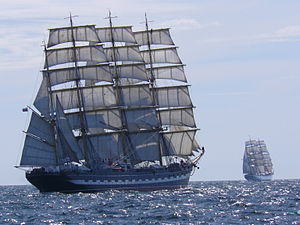Kruzenshtern (ship)

Kruzenshtern following the Statsraad Lehmkuhl
|
|
| History | |
|---|---|
|
|
|
| Name: | Padua |
| Namesake: | Padua |
| Owner: | F. Laeisz, Hamburg (1926–46) |
| Operator: | F. Laeisz, Hamburg (1926–46) |
| Port of registry: | |
| Route: | as Padua: between Hamburg & Chile |
| Builder: | Joh. C. Tecklenborg, Bremerhaven |
| Yard number: | 408 |
| Launched: | 11 June 1926 |
| Fate: | surrendered to the USSR as reparations 1946 |
|
|
|
| Name: | Kruzenshtern |
| Namesake: | Adam Johann Krusenstern |
| Owner: |
|
| Port of registry: | |
| Acquired: | 1946 |
| Identification: |
|
| Status: | in service |
| General characteristics | |
| Type: |
|
| Tonnage: | 3,064 GRT (as Padua) |
| Length: | 114.4 m (375 ft) |
| Beam: | 14.02 m (46.0 ft) |
| Height: | 51.3 m (168 ft) |
| Draught: | 6.8 m (22 ft) |
| Installed power: | 2 x 1,000 bhp 8-cylinder diesel engines |
| Propulsion: | sail & screw |
| Speed: | 17.3 knots (32.0 km/h; 19.9 mph) |
| Crew: | 257 |
| Notes: | Holds record for sailing between Hamburg and Australia via Chile: 8 months and 23 days |
The Kruzenshtern or Krusenstern (Russian: Барк Крузенштерн) is a four-masted barque that was built in 1926 at Geestemünde in Bremerhaven, Germany as the Padua (named after the Italian city). She was surrendered to the USSR in 1946 as war reparation and renamed after the early 19th century Baltic German explorer in Russian service, Adam Johann Krusenstern (1770–1846). She is now a Russian sail training ship.
Of the four remaining Flying P-Liners, the former Padua is the only one still in use, mainly for training purposes, with her home ports in Kaliningrad (formerly Königsberg) and Murmansk. After the Sedov, another former German ship, she is the largest traditional sailing vessel still in operation.
Launched in 1926 as the last of the P-Liners, the Padua was commissioned as a cargo ship, used among other things to ship construction material to Chile, South America, returning with saltpeter around Cape Horn. Later she transported wheat from Australia. Her maiden voyage from Hamburg to Talcahuano, Chile took 87 days. In 1933–1934 she took a record-breaking 67 days from Hamburg to Port Lincoln in South Australia. Prior to World War II she made 15 long trips to Chile and Australia. Her fastest voyage was in 1938–1939, from Hamburg via Chile to Australia and back to Hamburg in 8 months and 23 days under Captain Richard Wendt — a World record voyage for tall ships that has never been broken.
...
Wikipedia
